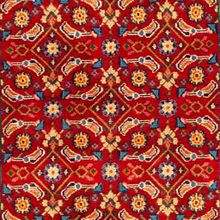Moud Rug
| Moud Rug | |
|---|---|
 Design of Mood Rug (Rugman) | |
| General information | |
| Name | Mood Rug |
| Original name | قالی مود |
| Alternative name(s) | Mood Carpet |
| Origin | |
| Category | Village |
| Technical information | |
| Common designs | Medallion, Herati (Fish) |
| Common colors | Navy Blue, Red, Blue, Brown |
| Dyeing method | Natural, Synthetic |
| Pile material | Wool, Silk |
| Foundation material | Cotton |
| Knot type | Asymmetrical (Persain), Jufti |
Mood rugs, reputed to be among the finest in the world, are hand woven in the city of Mashad in the Province of Khorassan. This great weaving center is also a trade center for the rugs produced in the neighboring towns and villages. You may notice that Mood rugs have some characteristics that are similar to a rug produced in Birjand. Although most are woven in workshops in the city, it is possible to find occasional Mood rugs that have been woven on a home loom. Skilled artisans use the asymmetrical Persian knot in the creation of this very special carpet as it offers more precision when weaving the intricately detailed patterns.
History
Materials
Foundation and Pile
Techniques and structures
Color and dyeing
The usual color characteristic in Moud carpets is pomegranate-red (from cochincal) in the field, although a small percentage has dark blue instead. In addition, different shades of red, blue, beige, gold, green, cinnamon, brown, and gray appear in the borders, design elements, and outlines.[1]
Motifs and Designs
The designs are floral in either a medallion or allover style. The Shah Abbas palmette with leaf and vine motifs is a popular Moud pattern. Occasionally, the traditional Boteh (paisley), Herati (fish), Lattice, or Minakhani (rosette-linked trellis) styles are woven for the field. The border has traditional Khorasan designs with large palmettes, leaves, and vines.[2]
Weaving techniques
Moud Khorasan sizes range from approximately five feet by three feet to large room dimensions.The Persian (asymmetric) knot is always used. Early weavings are in a secondary grade quality compared to MESHAD Khorasan carpets.[3]
See also
References
Bibliography
- Abraham Levi Moheban, (2015), The Encyclopedia of Antique Carpets: Twenty-Five Centuries of Weaving, NewYork: Princeton Architectural Press.